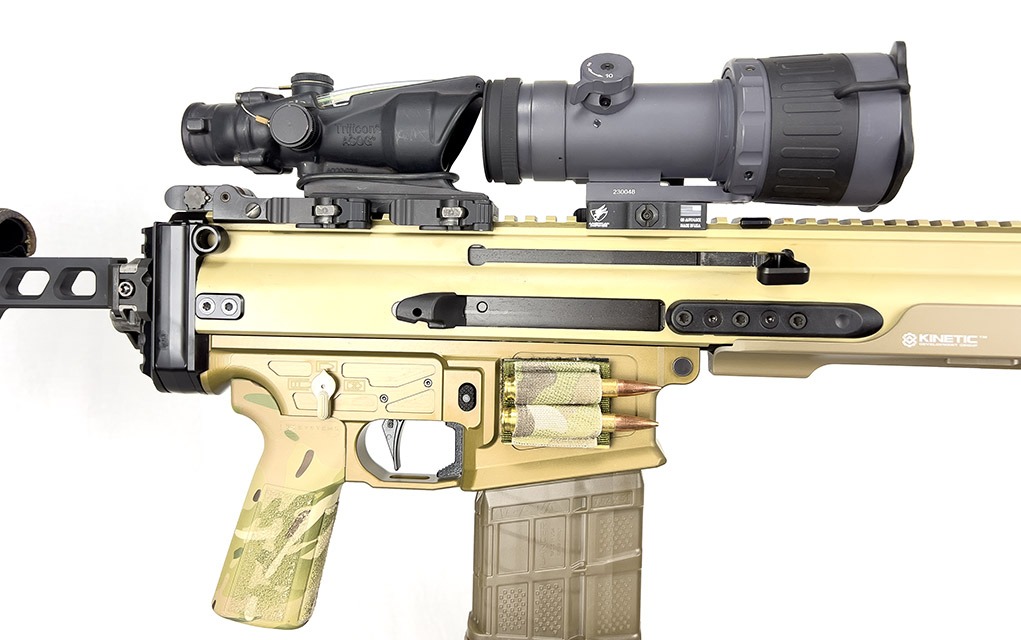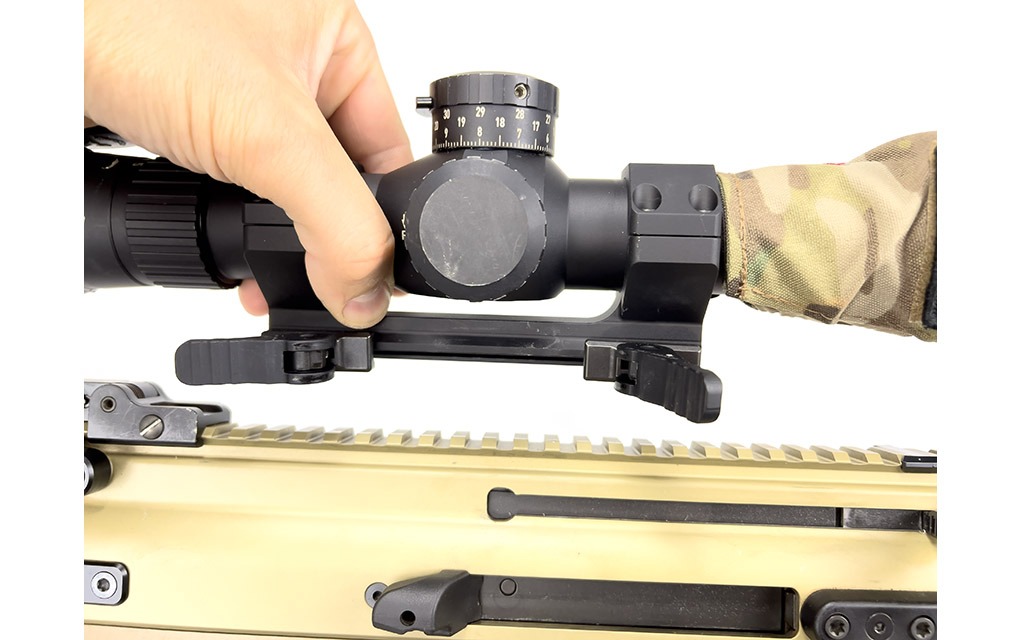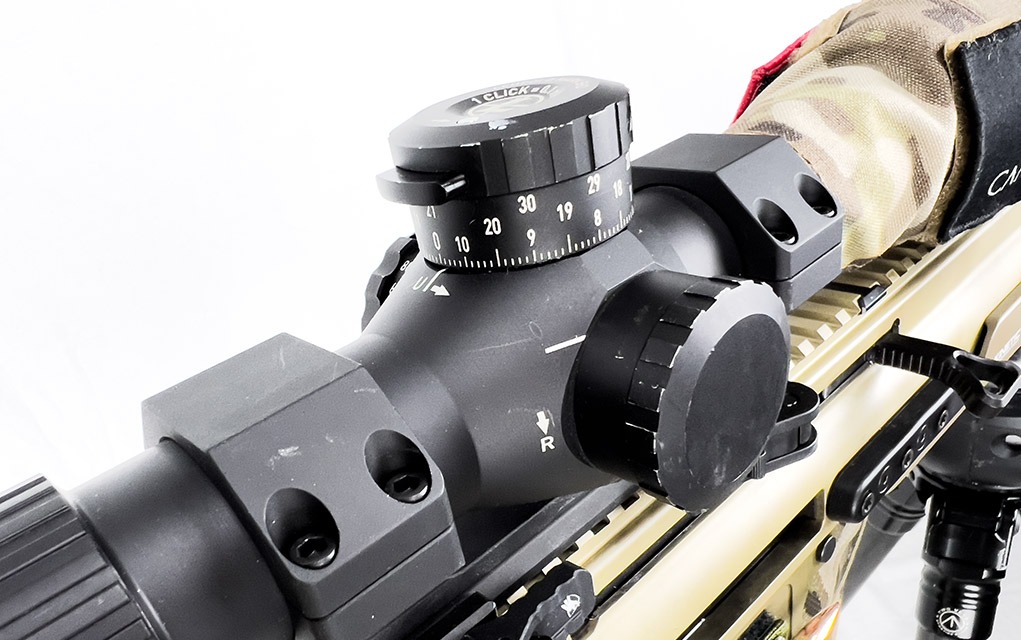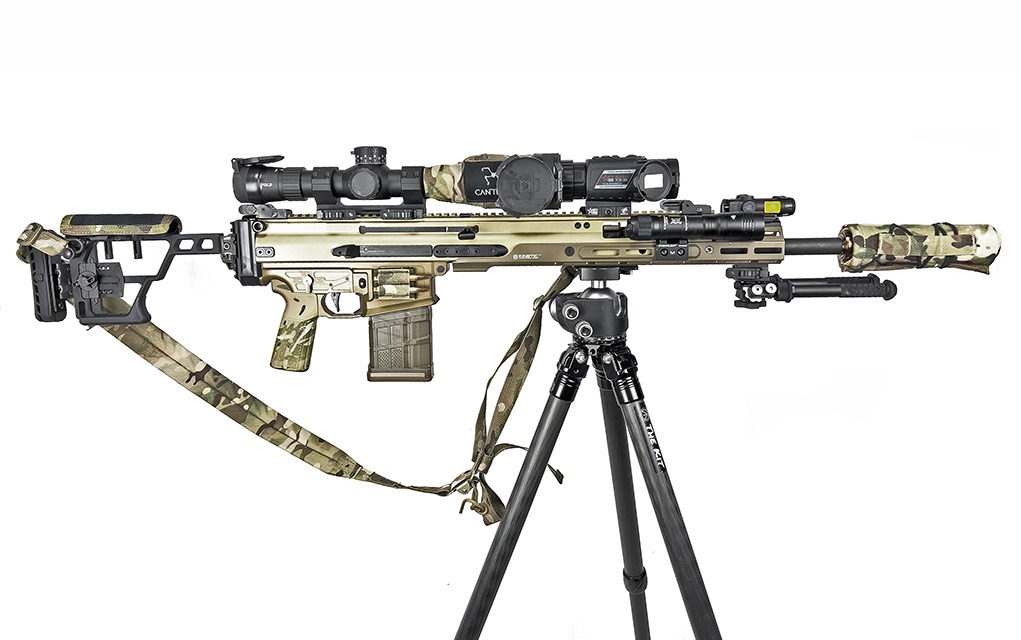
Want to maintain a repeatable rifle zero while switching an optic between guns? With modern machining, that’s now pretty easy.
The subject of rifle zeros comes up constantly, sometimes to the point of being repetitive and annoying. People treat a proper zero as a one-time thing, almost like a rare occurrence, often specific to a single load that they use.
What I plan to show you here is that getting a zero on a rifle is not only very easy, but you can also go so far as to have repeatable zeros after taking off the scope and moving it from gun to gun and load to load.
This isn’t magic with today’s optics technology. In fact, it’s simple.
Zero Understanding of the Topic
A longtime myth has persisted that a zero is hard to achieve, and it shouldn’t be touched once you get it “on.”
For a large part of our history, as shooters, we had a bit of a conundrum in that the rifles were very accurate, but the only way to aim them was with metallic sights. Optical sights, at the same time, were less than ideal and very fragile. Metallic sights were arguably perfected in the 1860s to 1880s and reached zenith during the height of Western expansion. Finely adjustable sights were relatively commonplace and ended up being simplified and further refined as the smokeless powder era began.
For a time, military rifles—not just target versions—had metallic sights that offered correction not just for elevation and windage, but also for spin drift. All these advancements were great … but limited by human eyesight. The final, and truly remarkable, set of adjustable sights came with the M1 Garand, later translated to the M14. Unlike their European counterparts who relied on their squad or division armorer to make sight adjustments, the individual American was able to independently zero their own rifle and make use of functional bullet drop compensation by way of a generalized elevation turret for as-issued ammo.
Zeroing the M1 rifle is very simple. Bottom out the rear sight, center it to the middle indicator line and count up eight clicks. You should be on for point-blank impact out to around 250 yards on a man-sized target with 150-grain M2 Ball loads. It’s just as simple on the M14 and M16 variants … but with some minor changes.
What you should understand is that, as a mechanical issue, zeroing generally isn’t hard to accomplish. What was hard to accomplish for the better part of a century was the manufacture of reliable optics.
Today, we’re at that point where optics have essentially caught up to guns in terms of repeatability, and the marriage of these systems is making for much more flexible, complete packages. Think of today’s optics in this sense, the same as a good set of irons. There isn’t a need to complicate it past that in regard to mechanical terms. The rest is largely subjective in value from one shooter to the next.

Chasing Perfection
Simply put, the zero of a rifle is the location in which your primary aiming point intersects the bullet’s flight path. Where it gets muddy is trying to understand why people use different zeros, such as the 25-meter, 50-yard, 100-yard, etc. The baseline understanding you need here is that bullets never “rise,” as in gain altitude in relation to the barrel. Once they exit the muzzle, they begin falling.
When you hear or read about the bullet in this sense, it is, in fact, in relation to what you’re seeing through the optic or sights. The sights are mounted at an angle to the barrel in all cases, even if it’s minute. It’s possible for the bullet to rise and fall within your sight in relation to the aiming point, but it’s always dropping.
Depending on the cartridge, there can be a little or a lot of variation to this situation. As an illustrative example, I’ll use the .450 Bushmaster, a cartridge I’ve used heavily for hunting.
Let’s assume that we’re using a 245-grain Hornady American Whitetail factory load. This is a common, reliable load that I’ve used favorably for years. In a mil reticle, using a 100-meter zero (I like mils in metric because of how easy the divisions are, and my home range is in meters, so it all meshes well), I will have 2 mils of drop at 200 meters. Fairly cut and dry.
To the shooter’s eye, that appears to be a lot of drop at that distance, making for a less confident shot if using only holdover to aim. I could dial 2.0 mil and be perfectly on, which is very applicable to this situation given a known range.

So, what happens if a buck walks out at 75 yards? Well, you’ll be pretty high unless you crank that turret back down. The best solution is to zero the rifle 1 mil high at 100 meters, making for a drop of 1 mil at 200 and perfect zero at 150 meters. This allows the shooter (me) to aim essentially dead-on at all ranges inside 200 meters, which is usually the max I will fire a straight-wall case for hunting, given how I hunt.
See, the bullet is dropping at the same rate no matter what I do. By using a modern optic, I can make use of the perceived advantage of fast aiming points.
Is holding at 2 mils with a 100-meter zero the same as holding at 1 mil on a 150-meter zero? To answer my own question, it is, in fact, different in practice, just not in general principle. It’s all how the eye interprets what you know to be the trajectory under pressure.
Now, just to make things worse, let’s throw in another load I like a lot, the Remington 260-grain Core-Lokt Tipped. Now, it does shoot a bit flatter than the Hornady load in my rifle. As a result, I have a 150-meter zero that’s .3 mil high and .3 left. I can very easily move my optic up to this new zero and enjoy only a .5 mil drop at 200 meters, not crossing the 2 mil line until 250 meters. I can keep this data handy in case I need to swap in ammo for a given hunt.
Keeping notes of zero isn’t hard and is especially important when you also shoot subsonic … in this case, the 395-grain Hornady SubX.
Tracking a third zero on one scope isn’t hard, either. For instance, I drop 5 mils off zero compared to supersonic, but at 100 meters, it’s still lethal and pretty quiet through a suppressor. On a straight-wall case hunting rifle, I’m tracking three zeros on one scope like it’s nothing. You can do this, too, and it isn’t magic. Once you break the code on zeros, it becomes just like the M1 sight we mentioned here: a simple, repeatable means of making the most of your gear. Most high-end scopes have zero stops these days, making resetting your equipment to baseline zero very easy.
The old days of the voodoo of zeroing are gone, so let’s now look at more things to challenge the foundation of your zero understanding.
Plug-and-Play
Taking the zeroed scope off a rifle used to be utterly verboten if you were a serious shooter. There is nothing wrong with installing a scope and not moving it, but things happen and you may find yourself in need of removing it. Now, bear in mind this is again a new-age proposition. To take advantage of this capability, you need mounts that return to zero after being taken off, meaning that they will be within +/- your established zero. I have found that ADM, KDG, LaRue, and Midwest Industries make some extremely repeatable QD mounts. I have field experience with all these brands, but I use ADM the most.

So why would a person want to have multiple scopes for one gun … or even the ability to swap optics out to begin with? The answer is the same as before: We have the tech now, so why limit yourself?
When I started using night vision and thermal optics, this became a must. I often have zeros established not just for a given load but also for a given rifle. Yes, I do swap in different optics for the purposes I may need them. For instance, I keep my Leupold MK5 HD 5-25X zeroed for my customized FN SCAR 20S in .308 Win. at 200 meters with BHA 168-grain Match, but I also keep zero records for Remington 150-grain Tipped Core-Lokt and Hornady 178-grain ELD loads.

This scope also has recorded zeros for my .450 Bushmaster, 6.5 Creedmoor bolt guns and another .308 bolt gun. I like this scope as a day optic, but I can use it with thermal or night vision clip-on systems as well. If I want a dedicated thermal sight, I simply detach my Leupold and install the Armasight optic I have here in a KDG mount. This optic is advanced, and I can keep track of zeros on it as well. The entire system is seamless, and because these mounts can be installed with the exact same pressure each time, I don’t have to worry about losing zero at all.

Troubleshooting Zeros
Now let’s talk about some problems shooters have encountered when I’ve shown them these systems between rifles and cartridges, as well as how the optics interact with them:
1. Reticle Types
The reticle type you’re using doesn’t matter. There, I said it. For all purposes, bullet A is leaving the muzzle at X velocity and will travel a predictable trajectory. Bullet B does its own thing, but both are falling at their respective rates. If you like mils, use them. The same goes with MOA. I have probably a dozen different reticles I use in all measurements—it’s not hard, but you do have to take the time to learn your system. Again, back to our M1 sight: The mechanical function is ignorant of the rifle you mount it to. It’ll zero again if your mount is repeatable, and you move the adjustments to their known point of zero.
2. Height Over Bore
Optical height over bore doesn’t matter. It’s been proven that you can mount a scope a foot above the gun and still use it normally in a functional sense … but not an ergonomic one. Most of my optical mounts are at about 1½ inches above the optical centerline. I can use clip-on thermal or NVDs at this height and that’s what I like the most. Some people like lower centers, but that is a preference and I respect it. Lowering your scope to the bore doesn’t flatten bullet trajectory. Remember that the bullet is leaving the muzzle and dropping at a constant rate.

3. Zeroing Problems
These are machines we’re talking about here, and like any human invention, they can be made to fail … or simply fail on their own. People have trouble zeroing in most cases because they often skimp on their mounts or don’t properly install scope bases. In most cases, you get what you get in life where quality is concerned. If you cut costs, you’ll get a degree of performance relative to that. Most guns shoot well enough today to take advantage of high-end optics. There’s somehow a mental hang-up with people putting good glass on budget guns, but if you have a QD mount and recorded zeros, why not use the better optics? You can have a couple guns and one good scope. As long as the quality is good (gun, optics and mounts), you can mix and match with confidence. Just don’t expect this at lower price points.
4. QD vs. Clamp Mounting
This is where I separate from some professional shooters and writers. I don’t like torque wrenches to install optics. I used to do this with my Geissele and Badger mounts, and I found that I was getting less-than-ideal results for repeatability, gun-to-gun. The thing I found is that the recommended foot-pounds to tighten the mounts down varies from rail-to-rail and gun-to-gun. That’s no good. Now I need to not only record rail position, but screw torque for each gun? That’s ineffective, and I don’t recommend it.

I like the lever-style QD mounts because they offer simple, repeatable pressure per gun with no additional tools. These mounts have faceted screws that control lever pressure. Basically, you’re “zeroing” your base to the individual rail on each gun. I establish a “base” gun for each mount where it usually lives. Then, if I need to mount it on another gun, I just move it the appropriate number of clicks to that spot, and voila, I have consistent locking pressure every time without needing a wrench.
That said, I will usually not remove mounts like the Geissele and Badger once I have them installed because of needing to torque them to one gun at a time for repeat zero. The risk of crushing the rail or damaging the mount is much higher here as well, and if you damage the threads, it will change mounting pressure.
Many people see 65 foot-pounds of torque and say, “Well, if 65 foot-pounds is good, 85 foot-pounds must be better.”
Yikes.
Editor's Note: This article originally appeared in the September 2024 issue of Gun Digest the Magazine.
More On Scope Mounts & Rings:
- A Ring For Every Occasion: Scope Rings And Base Systems
- How To Properly Mount A Scope On A Rifle
- What Is A Quick-Detach Scope Mount?
- The Real Avid Level-Right Pro Scope Mounting System

Next Step: Get your FREE Printable Target Pack
Enhance your shooting precision with our 62 MOA Targets, perfect for rifles and handguns. Crafted in collaboration with Storm Tactical for accuracy and versatility.
Subscribe to the Gun Digest email newsletter and get your downloadable target pack sent straight to your inbox. Stay updated with the latest firearms info in the industry.

![Best Concealed Carry Guns In 2025 [Field Tested] Wilson Combat EDC X9S 1](https://gundigest.com/wp-content/uploads/Wilson-Combat-EDC-X9S-1-324x160.jpg)


![Best 9mm Carbine: Affordable PCCs [Tested] Ruger Carbine Shooting](https://gundigest.com/wp-content/uploads/Ruger-Carbine-Shooting-100x70.jpg)
![Best AR-15: Top Options Available Today [Field Tested] Harrington and Richardson PSA XM177E2 feature](https://gundigest.com/wp-content/uploads/Harrington-and-Richardson-PSA-XM177E2-feature-100x70.jpg)
